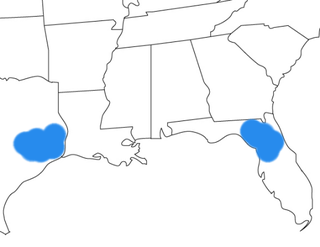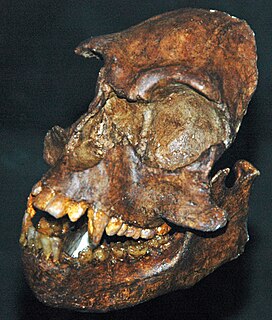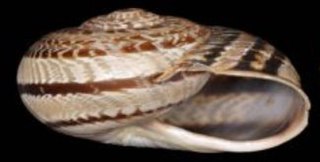
Tamias is a subgenus of chipmunks within the synonomous genus Tamias in the tribe Marmotini of the squirrel family. The subgenus includes a single living species, the eastern chipmunk The genus name Tamias means "treasurer", "steward", or "housekeeper", which is a reference to the animals' role in plant dispersal through their habit of collecting and storing food for winter use.

Diatomys is an extinct rodent genus known from Miocene deposits in China, Japan, Pakistan, and Thailand. The fossil range is from the late Early Miocene to the Middle Miocene.

Allognathus is a genus of air-breathing land snails, terrestrial pulmonate gastropod mollusks in the family Helicidae, the true snails. The genus is endemic to the Balearic Islands being present in all major islands and in several small islets. The genus colonized the archipelago from the south-eastern Iberian Peninsula during the Middle Miocene, throughout a land-bridge connection. The different species belonging to Allognathus live in crevice rocks or under stones.
Ia is a genus of bat in the family Vespertilionidae. It belongs to the subfamily Vespertilioninae and has been placed in the tribe Vespertilionini. In the past, it has also been considered a synonym or subgenus of the genera Pipistrellus or Eptesicus, which used to contain many more species than they do now. Ia comprises a single living species, the great evening bat (I. io) of eastern and southeastern Asia, and one extinct fossil species, I. lanna, from the Miocene epoch in Thailand. Another living species, I. longimana, was recognized in the past, but it is no longer considered a valid species distinct from the great evening bat.

Plithocyon is an extinct genus of hemicyonine bear of the Miocene epoch, endemic to North America and Europe. It lived from ~15.97—11.61 Ma, existing for approximately 4 million years.
Zaragocyon is an extinct monospecific genus of hemicyonine bear from the Early Miocene of Spain.
Euthecodon is an extinct genus of long-snouted crocodylid crocodilians. It was common throughout much of Africa during the Neogene, with fossils being especially common in Kenya. It existed from the Early Miocene to the Early Pleistocene.
Amphicyoninae is a subfamily of extinct bear-dogs, large terrestrial carnivores belonging to the suborder Caniformia and which inhabited North America, Eurasia, and Africa from ~37.2—2.6 Ma. Amphicyoninae existed for approximately ~34.6 million years.

The Thomas Farm site is an Early Miocene, Hemingfordian assemblage of vertebrate fossils located in Gilchrist County, northern Florida.

Hemicyoninae is an extinct subfamily of Ursidae often called "dog-bears", literally "half dog", bear-like carnivoran living in Europe, North America, Africa and Asia during the Oligocene through Miocene epochs 33.9–5.3 Ma, existing for approximately 28.6 million years. They are sometimes classified as a separate family.
Miniopterus zapfei is a fossil bat in the genus Miniopterus from the middle Miocene of France. First described in 2002, it is known only from the site of La Grive M, where it occurs with another fossil Miniopterus species, the smaller and more common Miniopterus fossilis. M. zapfei is known from five mandibles and an isolated fourth upper premolar (P4). The fourth lower premolar is more slender than in M. fossilis and the cingulum shelf surrounding the P4 is less well-developed than in living Miniopterus. The length of the first lower molar is 1.57 to 1.60 mm.
Lagrivea is a fossil genus of squirrel from the Middle Miocene of France. The single species, L. vireti, is known from three mandibles and two isolated teeth. All come from the fissure filling of La Grive L5, part of the La Grive-Saint-Alban complex in Saint-Alban-de-Roche, southeastern France. Lagrivea was a large tree squirrel with flat lower incisors and a large, triangular fourth lower premolar (p4). Each of the four cheekteeth bears a deep basin in the middle of the crown. The m3 is about rectangular in shape, but rounded at the back. Although m1 and m2 have two roots, m3 has three.
? Nycticebus linglom is a fossil strepsirrhine primate from the Miocene of Thailand. Known only from a single tooth, an upper third molar, it is thought to be related to the living slow lorises, but the material is not sufficient to assign the species to Nycticebus with certainty, and the species name therefore uses open nomenclature. With a width of 1.82 mm, this tooth is very small for a primate. It is triangular in shape, supported by a single root, and shows three main cusps, in addition to various crests. The absence of a fourth cusp, the hypocone, distinguishes it from various other prosimian primates.
Tupaia miocenica is a fossil treeshrew from the Miocene of Thailand. Known only from a single tooth, an upper first or second molar, it is among the few known fossil treeshrews. With a length of 3.57 mm, the tooth is large for a treeshrew. At the back lingual corner, the tooth shows a small cusp, the hypocone, that is separated from the protocone in front of it by a narrow valley. The condition of the hypocone distinguishes this species from various other treeshrews. In addition, the presence of a well-developed but simple mesostyle is distinctive.

Floridachoerus olseni is an extinct peccary that lived during the Hemingfordian age of the Early Miocene, and was endemic to North America. F. olseni was in existence for approximately 4.46 million years. Remains of this extinct mammal were located at the fossil rich Thomas Farm site in Gilchrist County, Florida and Toledo Bend site, Newton County, Texas. Floridachoerus olseni was named after Stanley. J. Olsen of the Florida Geological Survey in 1962. Olsen previously worked at the site for Harvard University.

Pliopithecoidea is an extinct superfamily of catarrhine primates that inhabited Asia and Europe during the Miocene. Although they were once a widespread and diverse group of primates, the pliopithecoids have no living descendants.
Crouzeliinae is an extinct subfamily of Pliopithecidae primates that inhabited Europe and China during the Miocene, approximately 8–14.5 million years ago - they appear to have originated in Asia and extended their range into Europe between 17 and 13 million years ago. Crouzeliines can be distinguished from the other Pliopithecoidea subfamilies on the basis of uniquely derived dental traits.

Hyotheriinae was a subfamily of even-toed ungulates that existed during the Miocene and Pliocene in Europe, Asia, and Africa.
Hadrodelphis is an extinct genus of dolphin once assigned to the paraphyletic/polyphyletic family Kentriodontidae. Remains have been found in the middle Miocene (Langhian) Calvert Formation of United States.

Allognathus hispanicus is a species of land snail in the family Helicidae, the true snails. This species is endemic to Mallorca, one of Spain's Balearic Islands. The common name is "caragol de Serp", due to the pattern of it shell.









